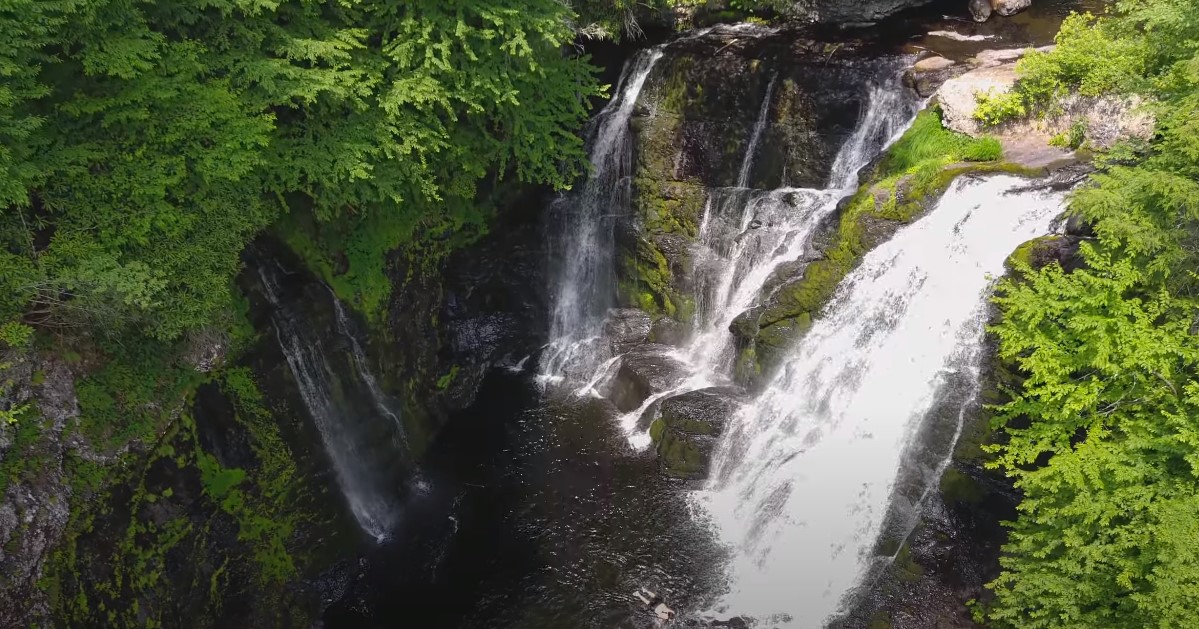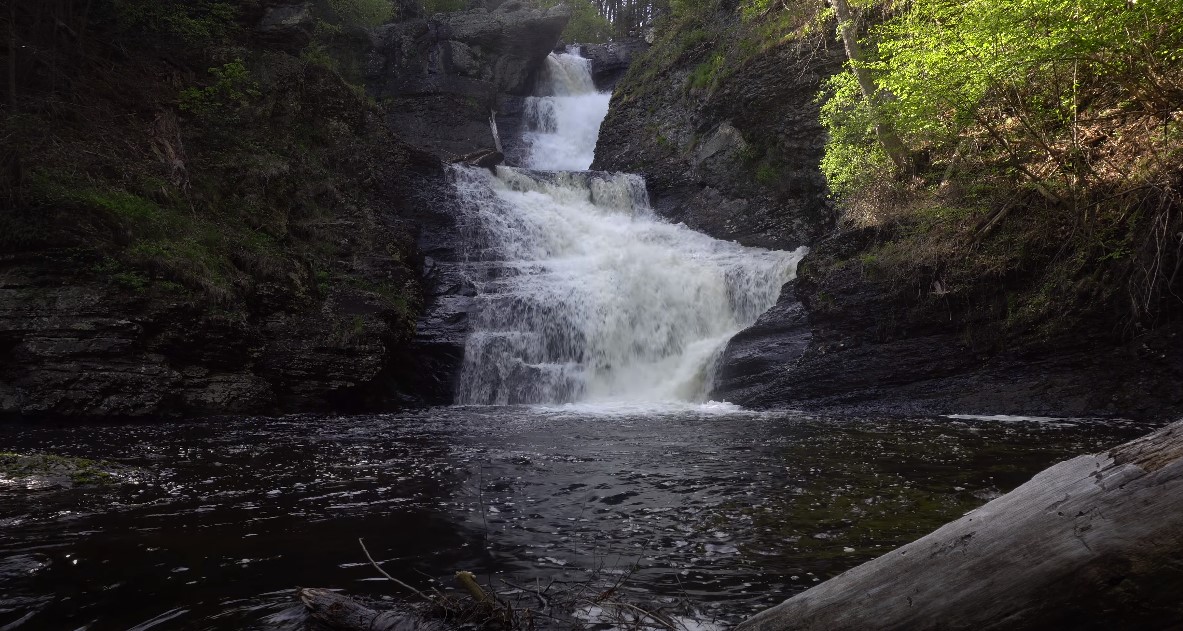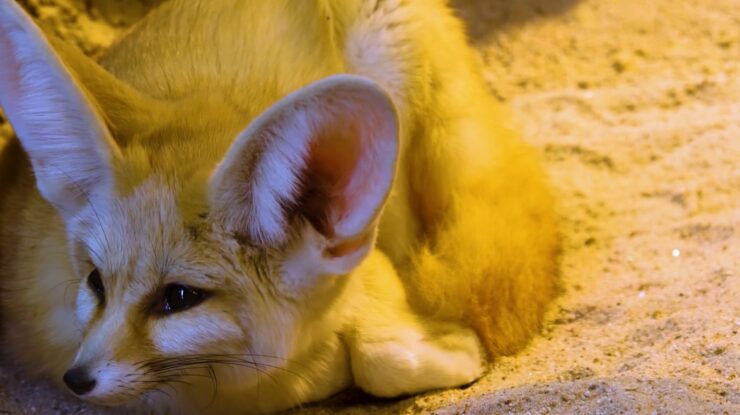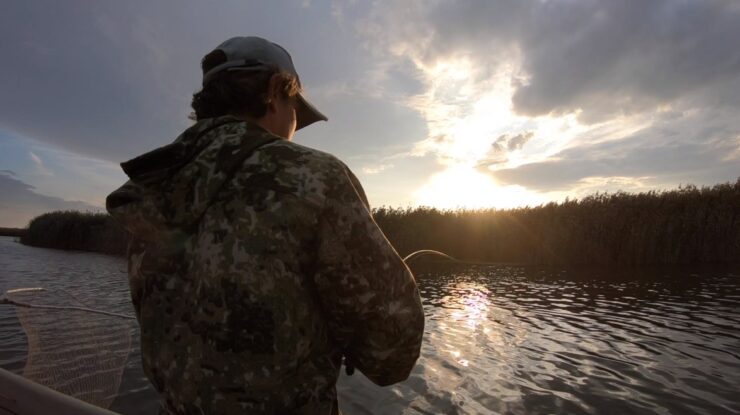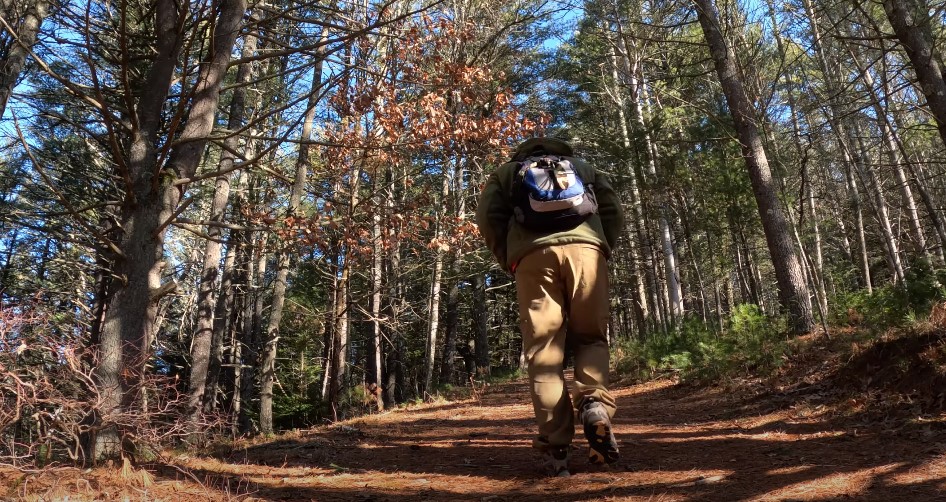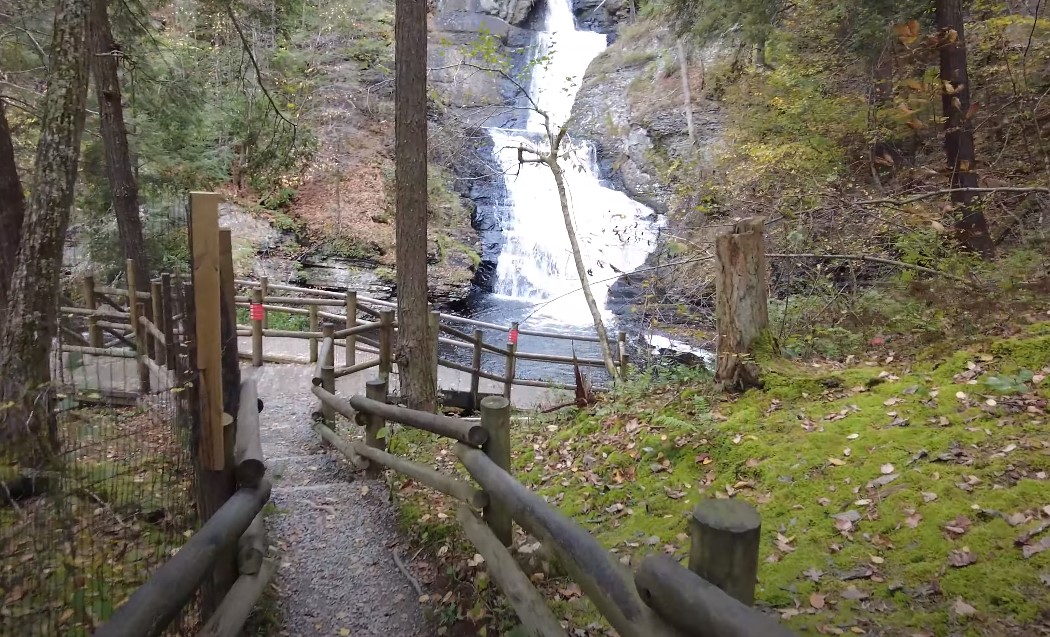Nestled within the enchanting Delaware Water Gap National Recreation Area, straddling the border of Pennsylvania and New Jersey, lies the captivating Raymondskill Falls. Rising proudly at a staggering height of 150 feet, this cascading wonder reigns as the tallest waterfall in the Keystone State.
Picture a mesmerizing “water gap” sculpted by the Middle Delaware River, skillfully winding its way between serene forested mountains and rugged rocky ridges. Journeying beyond this breathtaking national recreation area, the river ventures another 200 miles, flowing gracefully towards Delaware Bay and ultimately merging with the vast Atlantic Ocean in Wilmington, Delaware.
Nature enthusiasts can revel in the abundant offerings of the Delaware Water Gap National Recreation Area, a federally-protected haven nestled within the heart of one of the most densely populated regions in the United States. With over 150 miles of hiking trails, the park caters to all levels of adventurers.
From the wheelchair-accessible Dingmans Falls boardwalk trail to the exhilarating Mount Tammany Red Dot Trail, and even the legendary Appalachian Trail passing through, the possibilities for exploration are endless.
Behold, Raymondskill Falls
Where nature’s masterpiece unfolds. Unlike a conventional single-drop waterfall, Raymondskill Falls boasts a magnificent three-tiered spectacle, gracefully adorning Raymondskill Creek. The cumulative vertical drop of these tiers rivals the majestic one of the widest Niagara Falls, leaving visitors awestruck by its unparalleled beauty.
Millennia ago, as Pleistocene glaciers swept through northern Pennsylvania, they meticulously sculpted the landscape, leaving in their wake the awe-inspiring cascades of Raymondskill Falls. These icy giants chiseled the Delaware River valley, carving a path for Raymondskill Creek to flow and eventually giving birth to this natural wonder.
To fully immerse oneself in the grandeur of Raymondskill Falls, two viewing platforms await eager spectators. One platform rests near the falls’ origin, allowing for an up-close encounter with nature’s aqueous masterpiece. The second platform awaits at the imposing step that delineates the upper two tiers from the lower, inviting visitors to revel in the grandeur from a different vantage point.
Second Tallest In Pennsylvania
This 130-foot cascade awaits only a short journey down Route 209 from the Raymondskill Creek Trailhead. Accessible to all, this wheelchair-friendly trail ensures that everyone can partake in the wonder of Dingmans Falls. Although the second-tallest in the state, Dingmans Falls guarantees a viewing experience second to none.
Venturing beyond Raymondskill Falls and Dingmans Falls, the Pocono Mountains unfurl an array of captivating waterfalls. From the captivating Bushkill Falls, located just outside the Delaware Water Gap National Recreation Area, to the awe-inspiring Shohola Falls and Paupack Falls, nature’s symphony of cascading waters envelops this mesmerizing region.
Wildlife
While the Delaware Water Gap National Recreation Area finds itself enshrined within the bustling embrace of the United States’ most populous area, it teems with an astonishing array of wildlife. A harmonious coexistence of humans and nature intertwines here.
Traverse the trails towards Raymondskill Falls or explore other corners of this federally-protected sanctuary, and be greeted by a menagerie of mammals, avian wonders, and beyond.
Black Bear
Embark on a journey where encounters with majestic black bears are not uncommon. This national recreation area boasts one of the highest concentrations of these magnificent creatures nationwide, nurturing some of the largest black bears in the country.
As visitors relish in serene picnics, it is paramount to tidy up, leaving no trace behind. A bear accustomed to human leftovers can spell danger for both humans and the bear itself, leading to heightened aggression and potential unfortunate consequences. Remember, a fed bear becomes a threatened bear.
Witness the graceful presence of white-tail deer as they gracefully graze along the trails, their elegant frames adding to the tapestry of the Raymondskill Creek Trail. Wild turkeys often grace the park with their presence, foraging amidst the bountiful offerings strewn across the recreation area.
Other Animals
As you wander alongside the glistening waterways, keep a keen eye out for the playful antics of beavers, minks, and muskrats. Delight in the sight of great blue and green herons wading in the shallows, patiently seeking their next aquatic feast of fish, frogs, and crustaceans. And if fortune favors you, catch a glimpse of river otters frolicking in joy, a delightful encounter during your sojourn in the Delaware Water Gap National Recreation Area.
As night cloaks the land, a nocturnal symphony unfolds. Gray foxes, bobcats, and coyotes emerge stealthily, navigating the park’s labyrinthine trails in search of prey. Majestic owls spread their wings, embarking on graceful hunts for scurrying mice and other nocturnal creatures. As darkness descends, six species of bats grace the night sky, soaring over the park in a mesmerizing display of aerial acrobatics, voraciously devouring mosquitoes, moths, and other insects.
Fishing
Delve into the aquatic realm, and you’ll discover a vibrant underwater tapestry. Within the Middle Delaware River and its tributaries, a thriving community of 61 fish species thrives. Anglers are enticed by the abundance of game fish within the Delaware Water Gap area, with native species such as American shad, brook trout, yellow perch, and pumpkinseed beckoning them to cast their lines.
Additionally, other species like rainbow trout, smallmouth bass, largemouth bass, bluegill, green sunfish, black crappie, channel catfish, walleye, and muskellunge—native to North America but introduced prior to the park’s establishment in 1965—grace these waters. Yet, amidst this aquatic harmony, three invasive fish species—common carp, goldfish, and brown trout—have also found their way into these waters, disrupting the delicate ecological balance.
Camping
Furthermore, 62 river campsites, accessible solely by canoe or kayak, beckon adventurers seeking a more immersive experience within the Delaware Water Gap National Recreation Area. Here, campers can cast their lines, hoping to reel in a delicious dinner from the abundant river offerings. As twilight descends, bask in the serenity of the flowing river’s symphony, the gentle chorus of tree frogs, and the haunting melodies of owls.
Map Location
Raymondskill Falls, standing as the crowning jewel within the embrace of the Delaware Water Gap National Recreation Area, beckons intrepid explorers to embark on a journey of awe and discovery.
FAQs
How tall is Raymondskill Falls?
Raymondskill Falls stands proud at a height of 150 feet, making it the tallest waterfall in Pennsylvania.
What makes Raymondskill Falls unique compared to other waterfalls?
Unlike traditional single-drop waterfalls, Raymondskill Falls mesmerizes visitors with its three-tiered structure. The combined vertical drop of these tiers rivals the height of the renowned Niagara Falls, creating a breathtaking spectacle.
How was Raymondskill Falls formed?
The cascades of Raymondskill Falls were formed thousands of years ago by Pleistocene glaciers that once covered northern Pennsylvania. These glaciers carved out the Delaware River valley, allowing Raymondskill Creek to flow and create the stunning falls we see today.
Are there any viewing platforms at Raymondskill Falls?
Can I visit other waterfalls ln Recreation Area?
Absolutely! The Delaware Water Gap area is home to several other captivating waterfalls. Dingmans Falls, the second-highest waterfall in Pennsylvania, can be accessed via a short journey from the Raymondskill Creek Trailhead. Additionally, the region is adorned with remarkable waterfalls like Bushkill Falls, Shohola Falls, and Paupack Falls, offering visitors a diverse range of natural wonders to explore.
What wildlife can be encountered in the Delaware Water Gap National Recreation Area?
The park boasts a rich variety of wildlife. Black bears are among the prominent inhabitants, and the Delaware Water Gap area is known for having one of the densest black bear populations in the United States. White-tail deer, wild turkeys, beavers, minks, and muskrats can also be spotted.
Birdwatchers can enjoy the sight of great blue and green herons, as well as the playful river otters. At night, elusive creatures such as gray foxes, bobcats, and coyotes emerge, while owls and bats take to the skies.
Can I go fishing?
Yes, the Middle Delaware River and its tributaries within the recreation area offer ample opportunities for fishing. Anglers can try their luck with a variety of game fish species, including native ones like American shad, brook trout, yellow perch, and pumpkinseed.
Additionally, introduced species such as rainbow trout, smallmouth bass, largemouth bass, bluegill, green sunfish, black crappie, channel catfish, walleye, and muskellunge can be found. However, it’s essential to follow fishing regulations and be aware of invasive fish species like common carp, goldfish, and brown trout, which can disrupt the ecosystem.
Is there an entrance fee to visit Raymondskill Falls and the Delaware Water Gap National Recreation Area?
Yes, the Delaware Water Gap National Recreation Area does have an entrance fee. It is advisable to check the official National Park Service website or contact the park directly for the most up-to-date information regarding fees and permits.
Final Words
In conclusion, Raymondskill Falls is a hidden gem nestled within the Delaware Water Gap National Recreation Area. Its towering height of 150 feet and unique three-tiered structure make it a must-visit destination for nature enthusiasts. As you explore the park’s abundant hiking trails and immerse yourself in the beauty of the surrounding landscape, you’ll encounter a diverse array of wildlife, including majestic black bears, graceful white-tail deer, and playful river otters.
The Middle Delaware River and its tributaries offer excellent fishing opportunities, with a variety of native and introduced fish species to be found. Whether you’re camping at one of the developed campgrounds or enjoying the tranquility of the river campsites, the Delaware Water Gap area promises a memorable experience for all. Plan your visit and embark on a journey of awe and discovery to uncover the untamed treasure of Raymondskill Falls.

